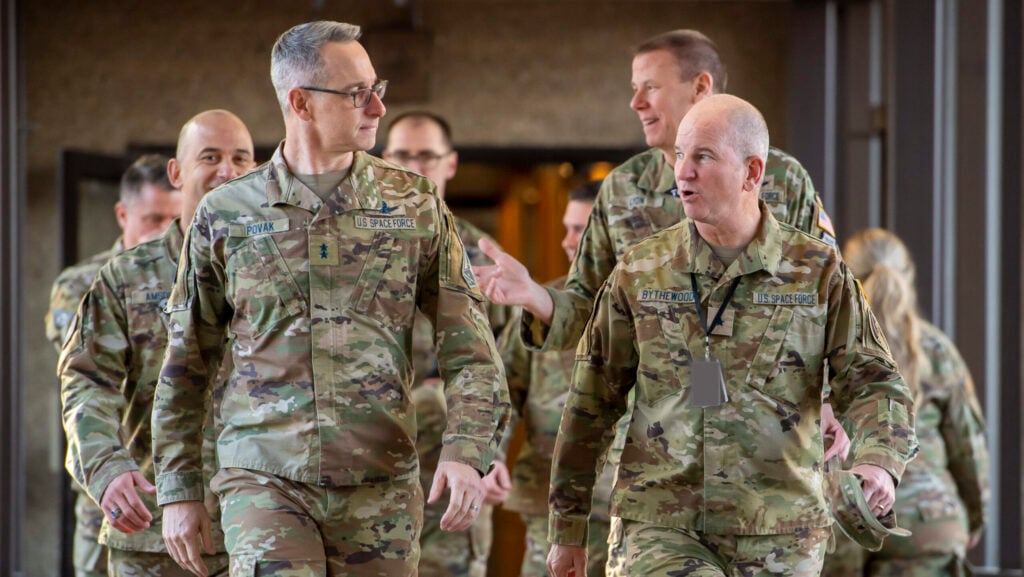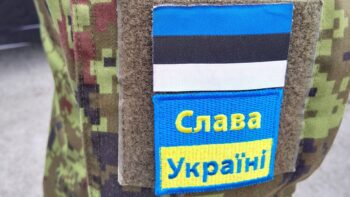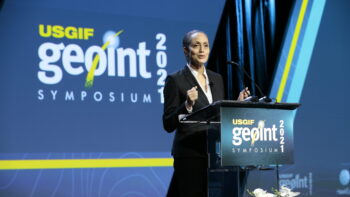
Maj. Gen. Christopher Povak, deputy director of the National Reconnaissance Office, speaks with Brig. Gen. Dennis Bythewood, commander of the Joint Task Force-Space Defense, during his visit to the organization at Schriever Space Force Base, Colorado, Dec. 12, 2022. (US Space Force photo illustration by Dennis Rogers)
WASHINGTON — The National Reconnaissance Office’s plan to “quadruple” the size of its satellite fleet over the next decade will allow it to deliver “10 times as many signals and images” as it is today, according to the spy agency’s deputy director.
“NRO is already building the largest and most capable, diverse and resilient overhead constellation in our history. We’re also putting new capabilities on orbit, on ground and everywhere in between,” Space Force Maj. Gen. Christopher Povak told the Mitchell Institute today.
The planned new satellites will be of diverse size stationed across diverse orbits, and NRO’s future architecture will include the continued use of commercial satellites to obtain “unclassified, shareable” data, he said.
“Proliferation and diversification of our architecture will provide increased coverage, capacity and resilience, and more timely delivery of data, create more persistent coverage over any area on the Earth provide faster and revisit rates and increase the accuracy and fidelity of our data. Such improvements will increase the competence and the relevance of NRO capabilities,” Povak explained.
That proliferation of spy sats is being enabled in part by speeding production, he noted. “[I]nstead of taking six to eight years to create one specific satellite, we’re now producing multiple satellites every year. With that inventory, with that production line, things like replenishment and reconstitution are becoming much more of a potential for us than certainly they were 10 or 15 years ago.”
While the NRO has never revealed exactly how many satellites it operates, historically its imaging and signals intelligence constellations have been made up of handfuls of very large birds.
For example, while the exact dimensions of the KH-11 series of electro-optical spy-sats are classified, they are believed to be about the same size as NASA’s giant Hubble Space Telescope — which sports a nearly eight-foot diameter mirror and weighs just under 25,000 pounds. (A KH-11 is believed to be the source of the classified satellite photo of a damaged Iranian missile launch pad infamously tweeted by former President Donald Trump in 2019.)
The NRO further is “shoring up vulnerabilities” in ground systems, including in the “cyber domain,” Povak said, along with exploring “advanced technologies and techniques like enhancing overhead tasking, collection and data processing capabilities to accelerate delivery of data to our users.”
All of these changes, he stressed, will help the agency stay ahead of threats from China and Russia and meet growing customer demands — including for more time-relevant intelligence, surveillance and reconnaissance data, something for which US combatant commanders long have been clamoring.
“The agility we’re building into inroads space data processing and command control architectures is allowing us to be more responsive, and we’re designing and developing systems that can provide more capability and missions enabling us to quickly pivot from supporting traditional national level analytic support to supporting military requirements for events like those in Ukraine,” Povak said.






















